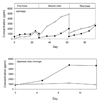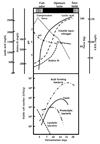Importance of lactic acid bacteria in Asian fermented foods
- PMID: 21995342
- PMCID: PMC3231931
- DOI: 10.1186/1475-2859-10-S1-S5
Importance of lactic acid bacteria in Asian fermented foods
Abstract
Lactic acid bacteria play important roles in various fermented foods in Asia. Besides being the main component in kimchi and other fermented foods, they are used to preserve edible food materials through fermentation of other raw-materials such as rice wine/beer, rice cakes, and fish by producing organic acids to control putrefactive microorganisms and pathogens. These bacteria also provide a selective environment favoring fermentative microorganisms and produce desirable flavors in various fermented foods. This paper discusses the role of lactic acid bacteria in various non-dairy fermented food products in Asia and their nutritional and physiological functions in the Asian diet.
Figures









Similar articles
-
Review - Lactic acid bacteria in traditional fermented Asian foods.Pak J Pharm Sci. 2017 Sep;30(5):1803-1814. Pak J Pharm Sci. 2017. PMID: 29084705 Review.
-
Health benefits of fermented foods.Crit Rev Food Sci Nutr. 2019;59(3):506-527. doi: 10.1080/10408398.2017.1383355. Epub 2017 Oct 20. Crit Rev Food Sci Nutr. 2019. PMID: 28945458 Review.
-
Impact of lactic acid bacteria and their metabolites on the techno-functional properties and health benefits of fermented dairy products.Crit Rev Food Sci Nutr. 2023;63(21):4819-4841. doi: 10.1080/10408398.2021.2007844. Epub 2021 Nov 30. Crit Rev Food Sci Nutr. 2023. PMID: 34845955 Review.
-
Ecological succession and functional characteristics of lactic acid bacteria in traditional fermented foods.Crit Rev Food Sci Nutr. 2023;63(22):5841-5855. doi: 10.1080/10408398.2021.2025035. Epub 2022 Jan 11. Crit Rev Food Sci Nutr. 2023. PMID: 35014569 Review.
-
Fruits and vegetables, as a source of nutritional compounds and phytochemicals: Changes in bioactive compounds during lactic fermentation.Food Res Int. 2018 Feb;104:86-99. doi: 10.1016/j.foodres.2017.09.031. Epub 2017 Sep 14. Food Res Int. 2018. PMID: 29433787 Review.
Cited by
-
Bacterial and Fungal Dynamics During the Fermentation Process of Sesotho, a Traditional Beer of Southern Africa.Front Microbiol. 2020 Jun 30;11:1451. doi: 10.3389/fmicb.2020.01451. eCollection 2020. Front Microbiol. 2020. PMID: 32695089 Free PMC article.
-
Potential Sustainable Properties of Microencapsulated Endophytic Lactic Acid Bacteria (KCC-42) in In-Vitro Simulated Gastrointestinal Juices and Their Fermentation Quality of Radish Kimchi.Biomed Res Int. 2018 Sep 3;2018:6015243. doi: 10.1155/2018/6015243. eCollection 2018. Biomed Res Int. 2018. PMID: 30255096 Free PMC article.
-
Woodfordia fruticosa fermented with lactic acid bacteria impact on foodborne pathogens adhesion and cytokine production in HT-29 cells.Front Microbiol. 2024 May 1;15:1346909. doi: 10.3389/fmicb.2024.1346909. eCollection 2024. Front Microbiol. 2024. PMID: 38751719 Free PMC article.
-
Lactic Acid Bacteria from Northern Thai (Lanna) Fermented Foods: A Promising Source of Probiotics with Applications in Synbiotic Formulation.Foods. 2025 Jan 14;14(2):244. doi: 10.3390/foods14020244. Foods. 2025. PMID: 39856910 Free PMC article.
-
Rice Bran Fermented with Kimchi-Derived Lactic Acid Bacteria Prevents Metabolic Complications in Mice on a High-Fat and -Cholesterol Diet.Foods. 2021 Jun 28;10(7):1501. doi: 10.3390/foods10071501. Foods. 2021. PMID: 34203398 Free PMC article.
References
-
- Lee CH. In: Importance of lactic acid bacteria in non-dairy food fermentation, in Lactic Acid Fermentation of Non-dairy Food and Beverages. Lee, C.H., Adler-Nissen, J. and Barwald, G, editor. HarnLimWon; 1994.
-
- Rhee SJ, Lee CYJ, Kim KK, Lee CH. Comparison of the traditional (samhaeju) and industrial (Congju) rice wine brewing in Korea. Korean J. Food Sci. Technol. 2003;12:242–247.
-
- Lee CH, Cho TS, Lim MH, Kang Jh, Yang HC. Studies on the Sik-hae fermentation made by flat-fish. Korean J. Appl. Microbiol. Bioeng. 1983;11:53–58.
-
- Lee CH. In: Food Science and Technology. Campbell-Platt, G., Wiley-Blackwell, editor. 2009. Food biotechnology; pp. 85–113.
MeSH terms
Substances
LinkOut - more resources
Full Text Sources
Other Literature Sources

